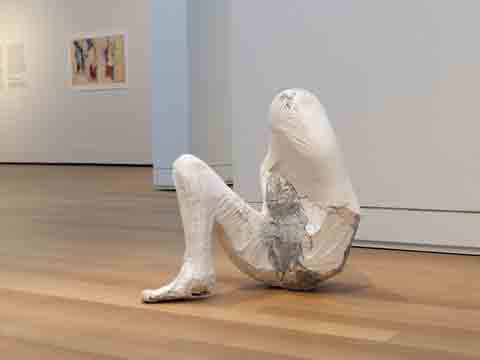
Yale University Art Gallery
As I entered the exhibit, my pace slowed, and my eyes widened. On the floor in front of me was a woman on all fours, who, though she didn’t have a face, appeared to be crying out in pain, or perhaps pleasure. She is one of the dozen plaster sculptures scattered around the floor of the Yale University Art Gallery in the Manuel Neri exhibit.
The exhibit was personally curated by outgoing famed Yale art curator Jock Reynolds. Manuel Neri was his teacher and mentor at the UC Davis. The exhibit is clearly deeply personal for Reynolds, who says in the gallery notes that the exhibit is: “my own ode to a great artist and teacher whom I have known and admired for almost 50 years.” Jock Reynolds announced his retirement, effective at the end of this academic year. He has worked as the Director of the Yale University Art Gallery for two decades.
The exhibit is entitled “Manuel Neri: The Human Figure in Plaster and on Paper.” Neri’s work is made with either of these two very fragile mediums. In the beginning of his career, he notes that he could only afford these materials, most often used for an artist’s first draft, but found such success with them that he continued. Another special exhibit on display in the Yale University Art Gallery adjacent to Neri’s is “Joel Shapiro: Paper, Plaster, Wood, and Wire.” It is striking that both artists use the mediums of paper and plaster. But that is where the resemblance stops. The showing of both exhibits simultaneously allows the viewer to contrast how two artists can manipulate the same medium.
The choice of medium lends an unfinished quality to Neri’s work, or a sense of perpetual construction. The exhibit consists of sketches and sculptures. The sketches are rough and haphazard, while the sculptures are missing limbs or heads, adding to the rough-hewn feeling.
Neri appears to have drawn inspiration from art history. I was struck by the feeling that many of the pieces had a Diebenkorn-quality, and later learned that Neri in fact studied under him during the Bay Area Constructivist movement. Both artists utilize planes of color adulterated with other hues, rough lines, and faceless figures. One piece looked like the “Winged Victory of Samothrace” without her wings: the female figure stands with one foot slightly in front of the other — a stance of triumph — and her chest thrust out. But the lack of wings and face robs her of the heroic quality of the ancient statue. And in fact, Neri’s conception of the human form differs widely from the idealization of the Greeks. His figures, mostly based on one model called Mary Julia, are imperfect. They have pubic hair, uneven breasts and hacked off body parts. Sculptures seem to depict a woman emerging from the wall, getting married, or rising like a ghost from the dead. Perhaps the intent is to represent women at several stages of life. Other sketches appear like a fashion designer’s illustration, and have a Monetesque quality in the few quick lines.
I found myself deeply immersed in the exhibit, but at times shocked and put on edge. Many of the pieces, especially the sculpture referenced at the very beginning, have a strong sexual undertone. Because of the breasts on each piece, it is clear that they are meant to represent women. Every figure is unclothed. Several sketches have red or blue paint splashed across them, evoking blood. One piece has a female sculpture seated on the edge of her chair, a common pose for an artist’s model — but she is underlifesize, and the juvenile aspect gave me a sense of unease. The rough quality of many pieces and the missing body parts add a layer of violence.
The gallery notes focus mainly on biographical information about the artist, and his relationship to the curator. There were also no title cards with descriptions accompanying the pieces, only a sheet of paper listing basic facts. With this lack of information, the viewer is left to wonder why the artist felt compelled to create these works. This leaves space for what many artists hope to occur, which is that the viewer will have an emotional reaction that leads to their own conclusion.
Claire Kalikman | claire.kalikman@yale.edu







